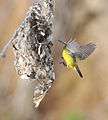Olive-backed sunbird
| Olive-backed sunbird | |
|---|---|
_-Singapore_Botanic_Gardens-8.jpg) | |
| Male | |
_-Singapore_Botanic_Gardens-8.jpg) | |
| Female | |
| Scientific classification | |
| Kingdom: | Animalia |
| Phylum: | Chordata |
| Class: | Aves |
| Order: | Passeriformes |
| Family: | Nectariniidae |
| Genus: | Cinnyris |
| Species: | C. jugularis |
| Binomial name | |
| Cinnyris jugularis (Linnaeus, 1766) | |
| Synonyms | |
| |
The olive-backed sunbird (Cinnyris jugularis), also known as the yellow-bellied sunbird, is a southern Far Eastern species of sunbird.
Taxonomy
In 1760 the French zoologist Mathurin Jacques Brisson included a description of the olive-backed sunbird in his Ornithologie based on a specimen collected in the Philippines. He used the French name Le petit grampereau des Philippines and the Latin Certhia Philippensis Minor.[2] Although Brisson coined Latin names, these do not conform to the binomial system and are not recognised by the International Commission on Zoological Nomenclature.[3] When in 1766 the Swedish naturalist Carl Linnaeus updated his Systema Naturae for the twelfth edition, he added 240 species that had been previously described by Brisson.[3] One of these was the olive-backed sunbird. Linnaeus included a brief description, coined the binomial name Certhia jugularis and cited Brisson's work.[4] The specific name jugularis is Medieval Latin for "of the throat".[5] This species is now placed in the genus Cinnyris that was introduced by the French naturalist Georges Cuvier in 1816.[6] There are 21 subspecies.[7]
Description
They are small songbirds, at most 12 cm (4.7 in) long. In most subspecies, the underparts of both male and female are bright yellow, the backs are a dull brown colour. The forehead, throat and upper breast of the adult male is a dark, metallic blue-black. In the Philippines the males of some subspecies have an orange band on the chest,[8] in Wallacea and northern New Guinea some subspecies have most of the underparts blackish, and in southern China and adjacent parts of Vietnam most of the underparts of the male are greyish-white.
Distribution and habitat
The olive-backed sunbird is common across southern China and Southeast Asia to Queensland and the Solomon Islands. Originally from mangrove habitat, the olive-backed sunbird has adapted well to humans, and is now common even in fairly densely populated areas, even forming their nests in human dwellings.[9][10]
Behaviour
Breeding
The birds mate between the months of April and August in the Northern Hemisphere, and between August and January in the Southern Hemisphere.[11] Both the male and the female assist in building the nest which is flask-shaped, with an overhanging porch at the entrance, and a trail of hanging material at the bottom end.[9]
After building the nest, the birds abandon the nest for about a week before the female returns to lay one or two greenish-blue eggs. The eggs take a further week to hatch. The female may leave the nest for short periods during the day during incubation. After the chicks have hatched, both male and female assist in the care of the young, which leave the nest about two or three weeks later.[10]
Feeding
The sunbirds are a group of very small Old World passerine birds which feed largely on nectar, although they will also take insects, especially when feeding young. Their flight is fast and direct on their short wings. Most species can take nectar by hovering, but usually perch to feed most of the time.
Gallery
 Olive-backed sunbird in the Philippines
Olive-backed sunbird in the Philippines
Male hovering while feeding 
female at nest Male of C. j. plateni at Manado Female of C. j. plateni at Manado
References
- ↑ BirdLife International (2016). "Cinnyris jugularis". IUCN Red List of Threatened Species. International Union for Conservation of Nature. Retrieved 8 May 2018.
- ↑ Brisson, Mathurin Jacques (1760). Ornithologie, ou, Méthode contenant la division des oiseaux en ordres, sections, genres, especes & leurs variétés (in French and Latin). Volume 3. Paris: Jean-Baptiste Bauche. pp. 616–618, Plate 32 fig 5. The two stars (**) at the start of the section indicates that Brisson based his description on the examination of a specimen.
- 1 2 Allen, J.A. (1910). "Collation of Brisson's genera of birds with those of Linnaeus". Bulletin of the American Museum of Natural History. 28: 317–335.
- ↑ Linnaeus, Carl (1766). Systema naturae : per regna tria natura, secundum classes, ordines, genera, species, cum characteribus, differentiis, synonymis, locis (in Latin). Volume 1, Part 1 (12th ed.). Holmiae (Stockholm): Laurentii Salvii. p. 245.
- ↑ Jobling, J.A. (2018). del Hoyo, J.; Elliott, A.; Sargatal, J.; Christie, D.A.; de Juana, E., eds. "Key to Scientific Names in Ornithology". Handbook of the Birds of the World Alive. Lynx Edicions. Retrieved 8 May 2018.
- ↑ Cuvier, Georges (1816). Le Règne animal distribué d'après son organisation : pour servir de base a l'histoire naturelle des animaux et d'introduction a l'anatomie comparée (in French). Volume 1. Paris: Déterville. pp. 388–389.
- ↑ Gill, Frank; Donsker, David, eds. (2018). "Dippers, leafbirds, flowerpeckers, sunbirds". World Bird List Version 8.1. International Ornithologists' Union. Retrieved 8 May 2018.
- ↑ Christian Perez. "The Birds of Alabang Hills". Retrieved May 15, 2011.
- 1 2 Olive-backed Sunbird Archived 21 December 2014 at the Wayback Machine.
- 1 2 Sunbird letters
- ↑ Breeding biology of the Yellow-bellied Sunbird Nectarinia jugularis in Northern Queensland
- Sunbirds by Cheke, Mann and Allen, ISBN 1-873403-80-1
External links
- Olive-backed sunbird videos, photos & sounds on the Internet Bird Collection.
- BirdLife Species Factsheet
- Yellow-bellied sunbird video
- Images of female and chicks in nest
| Wikimedia Commons has media related to Cinnyris jugularis. |
